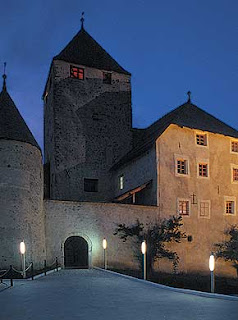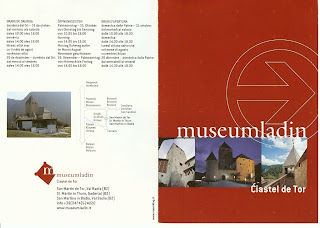
The Ladin Museum in San Martino (loc) might qualify as one of the best museums we have ever seen. The subject: the Ladin people and their culture and history. What makes this museum shine is a combination of factors.
- The history of the Ladin people is interesting because of the way they lived on and with the land, how they built their society and villages around little “viles”, and how they divided up farmland fairly so everyone had good farming land.
- The history of the Ladin culture is also interesting in that it intersects with many different waves of history so that in some ways you are taking a stroll through time as you learn about the Ladin. From the early alpine tribe called the Raetians (last centuries BC) who mark the start of the Ladin, to the Romanization of the Ladin, through all the countless monarchies that “owned” this area, through to WWI and WWII, it’s amazing that the Ladin culture and language has maintained itself so successfully.
- The museum is located in a very interesting old castle house in which you slowly make your way through various exhibits. The oldest part of the castle dates back to 1230.
- The audio guide for the museum is probably one of the best we’ve experienced. It’s sensitive to proximity so tracks automatically start when you are in a room or near an exhibit. The audio guide vignettes are either a story or in a question / answer format. In the story format, you walk into a “period” room (like a toy studio) and you are suddenly listening to a conversation between a mother, father, and son about how many (traditional) dolls would be carved and sold to support the family. Through the conversation you get a real sense of what life was like for them. Many rooms are tied together thematically around a typical Ladin family who might have lived on the premise. In the other format (question/answer) you have an interview with an expert on subject like geology or history. The questions the interviewer asks are exactly what you would ask yourself.
We spent 4 hours there and as we left they remarked that we had spent quite a bit of time there – a bit unusual I guess but definitely worth it. And the sad part is we didn’t even take time in the language “lab” part. So we could have spent another hour, but we were starving.
You can climb to the top of the tower and they have telescope devices which on first glance seem to just give views of the countryside, but as soon as you approach them and look through them, you view a narrated story about the view the telescope is focused on. Very clever.
Probably the most memorable exhibit was a room you walk into, sit down and suddenly find yourself in the middle of a dispute between the Bishop of Bressanone and the nuns of Castelbadia convent on whether the peasants should pay their tithes to the nuns. There are four characters in the conversation: Gregor Von Heimburg (a statesman), Kardinal Nilolaus Cusanus (Bishop of Bressanone), Verena von Stuben (Abbess of Castelbadia), and Herzog Sigmund von Tirol (a duke). The conflict came to a head in the Battle of Moreo in 1458. Each character is part of a painting and when they talk, the painting (really, a large LCD screen) comes to life. Again, very, very well done.

No comments:
Post a Comment
All comments are moderated. If your comment doesn't appear right away, it was likely accepted. Check back in a day if you asked a question.